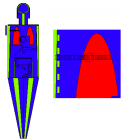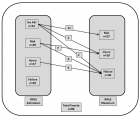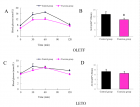About Panjab University
Panjab University
Articles by Panjab University
Bruxism: Its multiple causes and its effects on Dental Implants: A Review
Published on: 12th May, 2017
OCLC Number/Unique Identifier: 7286350944
The rehabilitation of partially or completely edentulous patients with implant supported prostheses has been widely used, achieving high success rates. However, many studies consider the presence of bruxism as a contraindication for this treatment modality. The purpose of this study was to review the literature and identify risk factors in implant supported rehabilitation planning in subjects with bruxism. The rehabilitation of bruxers using implant supported prostheses, using implants with adequate length and diameter, as well as proper positioning, seems to be a reliable treatment with reduced risks of failure. Bruxism control through the use of a night guard by rigid occlusal stabilization appliance, relieved in the region of implants, is highly indicated. Although it is clear that implant supported rehabilitation of patients with bruxism requires adequate planning and follow-up, well-designed randomized controlled trials are needed to provide reliable evidence on the long-term success of this treatment modality.
Fixed functional Appliances in Orthodontics-A review
Published on: 10th January, 2018
OCLC Number/Unique Identifier: 7379415494
Correcting class II malocclusion has always challenged an orthodontist owing to the complex and multifactorial aetiology. Age of patient and selection of the appliance plays an important role in the outcome of the treatment. Growth modification using functional appliances achieves stable results in class II patients. An orthodontist has wide variety of fixed and removable appliances for addressing a class II malocclusion. In this review article an attempt has been made to compile various available fixed functional appliances.
Synergistic interactions of sperm impairing bacteria: Impact on pregnancy outcome in mouse model
Published on: 9th April, 2021
OCLC Number/Unique Identifier: 9023207277
Earlier in our laboratory, the role of various individual sperm impairing microorganisms on sperm parameters and female infertility has been elucidated at higher doses. As, multiple bacterial species tend to exert more pathogenic effect in comparison to single organism hence, present study was carried out to evaluate that if consortia of these sperm impairing organisms can lead to infertility in female mice at sub fertility dose. For this, impact of individual bacterial strains of Escherichia coli, Pseudomonas aeruginosa, Pseudomonas aeruginosa, Klebsiella pneumoniae and consortia of Escherichia coli and Pseudomonas aeruginosa, Escherichia coli and Pseudomonas aeruginosa, Escherichia coli and Klebsiella pneumoniae was examined on the motility, viability of mouse spermatozoa and fertility outcome. The results showed that the individual bacterial strains of E. coli, S. marcescens and K. pneumoniae could led to immobilization of spermatozoa by agglutination and P. aeruginosa led to immobilization of spermatozoa without agglutination. Also, all of them led to 100% sperm death in 45 min of incubation. In case of consortia of bacterial strains, the results showed sperm agglutination in all the cases and they were able to induce 100% sperm death at 30 min of incubation time. Further, in vivo studies were carried out to evaluate the impact of individual bacterial strains and consortia of bacterial strains on the fertility outcome in female Balb/c mice. For this, female mice were administered intravaginally with 101 cfu/20µl of individual bacterial strains or consortia of strains for 10 consecutive days or PBS. The results showed that both individual bacterial strains and consortia of bacterial strains were able to efficiently colonize the mouse vagina. Further, control group receiving phosphate buffer saline and groups receiving individual bacterial strains showed all the pregnancy related changes viz. abdominal distension, string of pearls on palpation as well as delivery of pups on completion of gestation period and delivery of pups. The histological examination of reproductive organs viz. uterus and ovary, of the female mice receiving PBS or individual bacterial strains showed the formation of corpus luteum in the ovary and the formation of decidua’s in the uterus, indicative of pregnancy. However, mice receiving consortia of bacterial strains did not show any pregnancy related changes throughout the experiment. Thus, these results indicate that the presence of consortia of sperm impairing microorganisms in vaginal milieu is efficient in provoking infertility even at subfertility doses.
Does it matter what a mother consumes? An anthropological exploration of dietary practices among Churachandpur (Manipur) pregnant women and its impact on infant birth weight
Published on: 2nd September, 2019
OCLC Number/Unique Identifier: v
Background: Nutritional status of expectant women is an important indicator of healthy pregnancy and an ideal birth weight of the infant. The present study is an attempt to understand food eating practices and related taboos among the Paite women and whether or how these practices influence weight gain among infants during their first year of life.
Methods: The longitudinal study was conducted for a period of 16 months between November 2010 and February 2012) among 186 Paite mother-infant pairs. Women who had completed 37 to 42 weeks of pregnancy were included. Infant’s weights were measured using standard technique and information on mothers’ food related practices was recorded during the house visit using a structured schedule. Standard statistical methods were used for description and analysis.
Results: A peculiar practice, ‘pica’ was observed among a few women. A number of food taboos were found to be followed by the ‘Paite’ women during course of their pregnancy.
Conclusion: No significant difference was noticed in the mean weight of babies from birth through the age of 1 year between mothers practicing and not practicing food taboos. However, it was found that the mean weight of the babies throughout the study period was comparatively higher among non-taboo mothers. It could be suggested that women must be counseled during their antenatal and postnatal visits to the maternity clinics and hospitals about dietary practices and their anticipated impact on health of the newborns.

If you are already a member of our network and need to keep track of any developments regarding a question you have already submitted, click "take me to my Query."

















































































































































